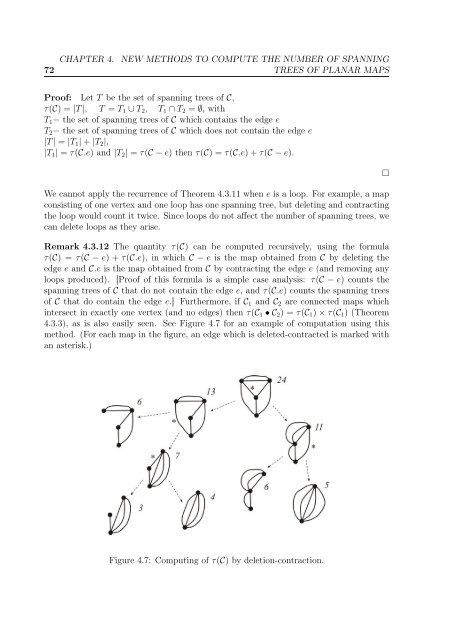enumeration of the number of spanning trees in some ... - Toubkal
enumeration of the number of spanning trees in some ... - Toubkal
enumeration of the number of spanning trees in some ... - Toubkal
You also want an ePaper? Increase the reach of your titles
YUMPU automatically turns print PDFs into web optimized ePapers that Google loves.
72CHAPTER 4.NEW METHODS TO COMPUTE THE NUMBER OF SPANNINGTREES OF PLANAR MAPSPro<strong>of</strong>: Let T be <strong>the</strong> set <strong>of</strong> <strong>spann<strong>in</strong>g</strong> <strong>trees</strong> <strong>of</strong> C,τ(C) = |T |, T = T 1 ∪ T 2 , T 1 ∩ T 2 = ∅, withT 1 = <strong>the</strong> set <strong>of</strong> <strong>spann<strong>in</strong>g</strong> <strong>trees</strong> <strong>of</strong> C which conta<strong>in</strong>s <strong>the</strong> edge eT 2 = <strong>the</strong> set <strong>of</strong> <strong>spann<strong>in</strong>g</strong> <strong>trees</strong> <strong>of</strong> C which does not conta<strong>in</strong> <strong>the</strong> edge e|T | = |T 1 | + |T 2 |,|T 1 | = τ(C.e) and |T 2 | = τ(C − e) <strong>the</strong>n τ(C) = τ(C.e) + τ(C − e).We cannot apply <strong>the</strong> recurrence <strong>of</strong> Theorem 4.3.11 when e is a loop. For example, a mapconsist<strong>in</strong>g <strong>of</strong> one vertex and one loop has one <strong>spann<strong>in</strong>g</strong> tree, but delet<strong>in</strong>g and contract<strong>in</strong>g<strong>the</strong> loop would count it twice. S<strong>in</strong>ce loops do not affect <strong>the</strong> <strong>number</strong> <strong>of</strong> <strong>spann<strong>in</strong>g</strong> <strong>trees</strong>, wecan delete loops as <strong>the</strong>y arise.Remark 4.3.12 The quantity τ(C) can be computed recursively, us<strong>in</strong>g <strong>the</strong> formulaτ(C) = τ(C − e) + τ(C.e), <strong>in</strong> which C − e is <strong>the</strong> map obta<strong>in</strong>ed from C by delet<strong>in</strong>g <strong>the</strong>edge e and C.e is <strong>the</strong> map obta<strong>in</strong>ed from C by contract<strong>in</strong>g <strong>the</strong> edge e (and remov<strong>in</strong>g anyloops produced). [Pro<strong>of</strong> <strong>of</strong> this formula is a simple case analysis: τ(C − e) counts <strong>the</strong><strong>spann<strong>in</strong>g</strong> <strong>trees</strong> <strong>of</strong> C that do not conta<strong>in</strong> <strong>the</strong> edge e, and τ(C.e) counts <strong>the</strong> <strong>spann<strong>in</strong>g</strong> <strong>trees</strong><strong>of</strong> C that do conta<strong>in</strong> <strong>the</strong> edge e.] Fur<strong>the</strong>rmore, if C 1 and C 2 are connected maps which<strong>in</strong>tersect <strong>in</strong> exactly one vertex (and no edges) <strong>the</strong>n τ(C 1 • C 2 ) = τ(C 1 ) × τ(C 1 ) (Theorem4.3.3), as is also easily seen. See Figure 4.7 for an example <strong>of</strong> computation us<strong>in</strong>g thismethod. (For each map <strong>in</strong> <strong>the</strong> figure, an edge which is deleted-contracted is marked withan asterisk.)□Figure 4.7: Comput<strong>in</strong>g <strong>of</strong> τ(C) by deletion-contraction.

















